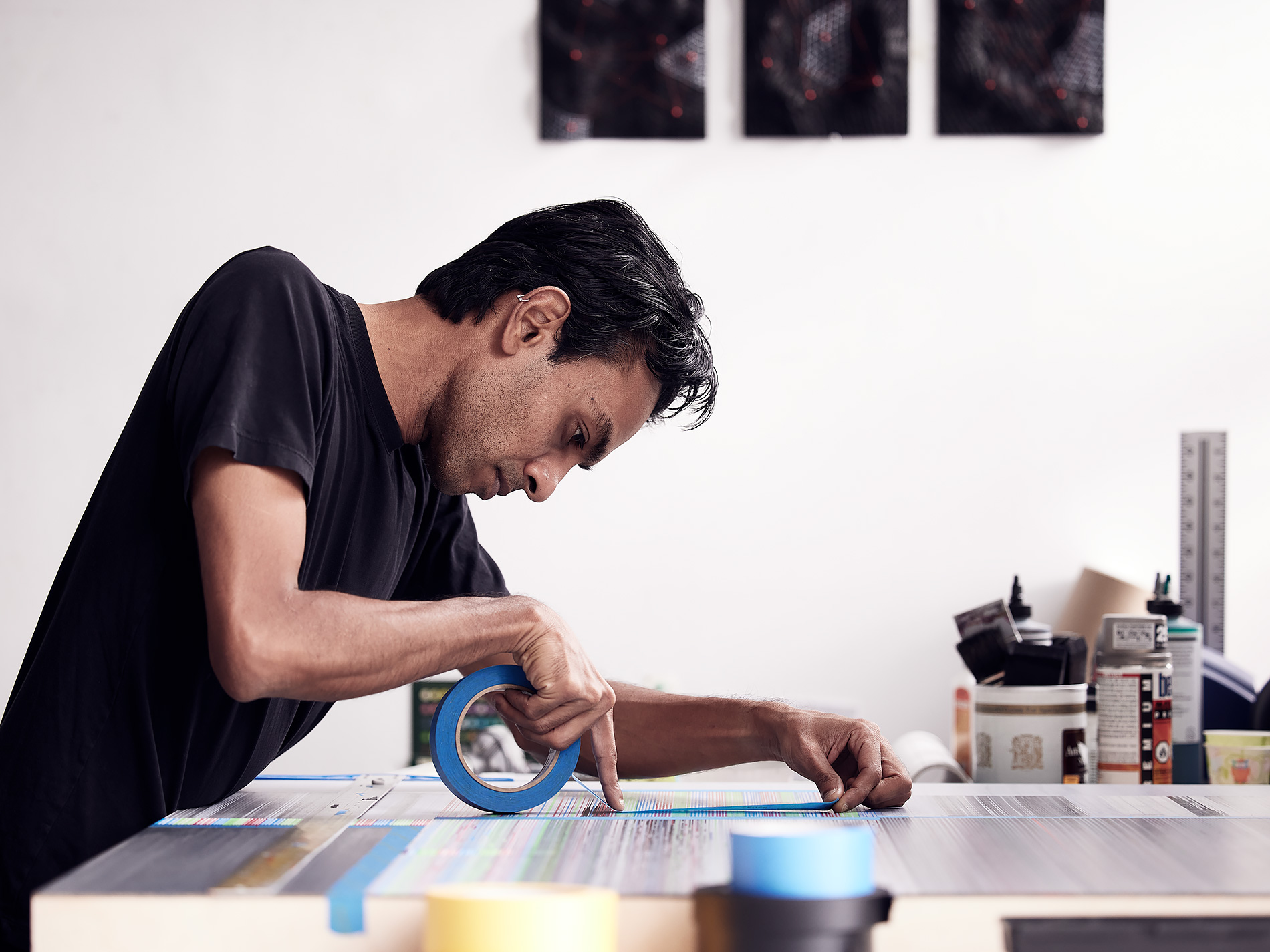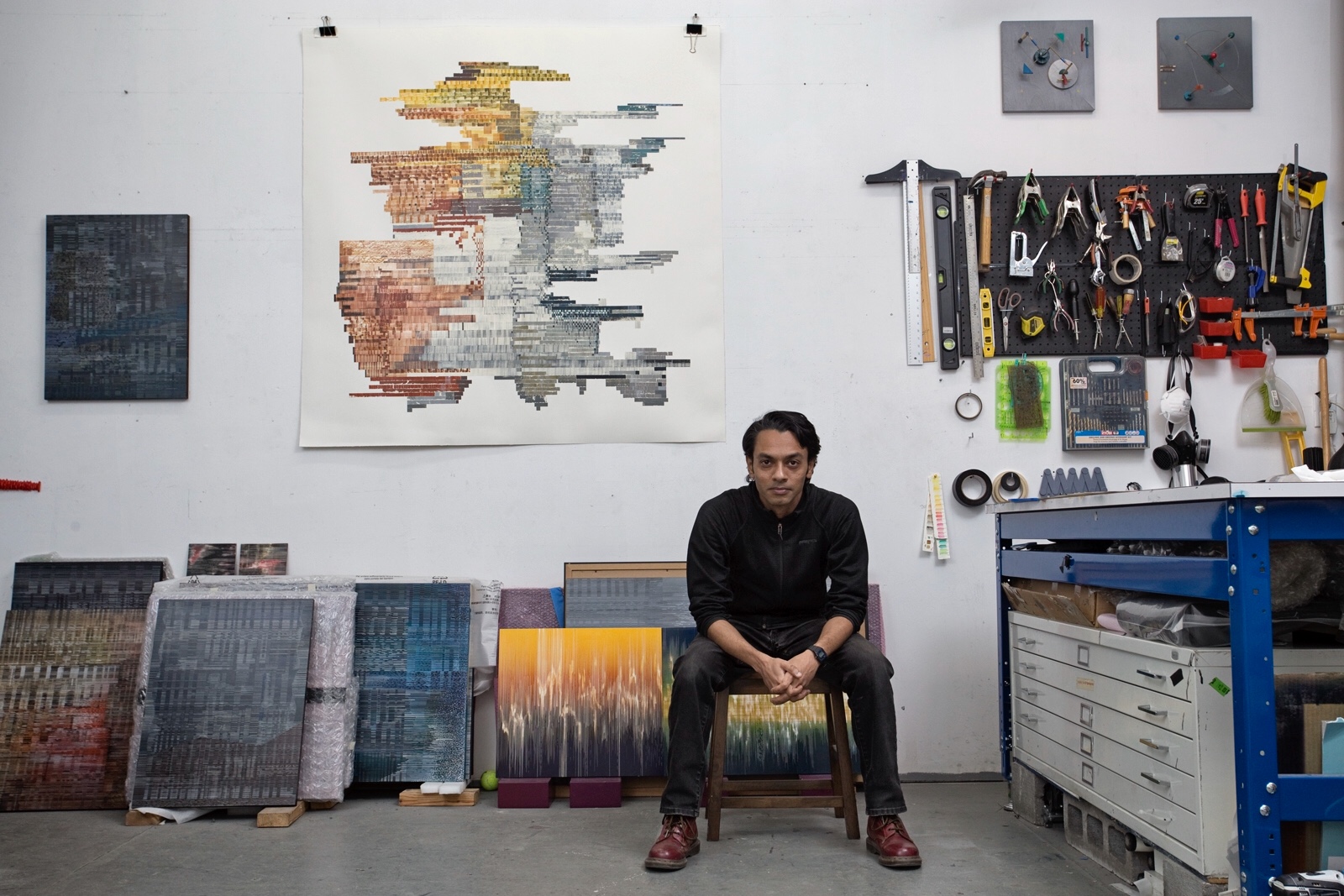Biography
Visakh Menon is an artist from India, based in Queens, New York. His interdisciplinary studio practice spans drawing, painting & media art with a focus on human machine interaction & it's impacts on visual perception. His current series of abstract drawings and paintings are driven by the practice of repetitive mark making as an act of meditation. These abstract works aim to create a visual space derived from algorithmic aesthetics with the repetitive lines creating optical & spatial shifts referencing screen space.
He received his M.F.A from the Maryland Institute College of Art in 2007. He is represented by BluePrint 12 Gallery in India and 1x1 Gallery, Dubai and his artworks are part of numerous corporate, public and private collections in the US and abroad. He has exhibited work in solo and group exhibitions in New York, Marfa, Miami, New Delhi, Kochi & Dubai. Menon currently also works as an independent creative director & branding designer and is an adjunct design faculty with the Communications Design Department at NY City College of Technology (CUNY)
Born 1980, Kochi, India
Education
- M.F.A Maryland Institute College of Art. (2007)
Fellowships & Residencies
- Institute of Electronic Art, Alfred University, New York (2023)
- Residency : Arteles, Finland (2015)
- NYFA Immigrant Artist Fellowship (2010)
- World Photo Press (2014)
Works Available At:
NOTE: I currently do not have a gallery representation in the US. Please contact me directly to schedule a studio visit or if you are interested in acquiring my artworks in the US.Solo Exhibitions
- Signal to Noise. 1x1 Gallery, Dubai
- Tremors. BluePrint12 Gallery, New Delhi
- Interference. SL Gallery, NY (06/2020, postponed)
- Signal / Noise, Fairleigh Dickinson University Gallery, NJ.
- Levels: Reene Weiler Gallery- Greenwich house, NYC.
- Installation. Memorial for Lost Connections: Chashama Windows space grant, NYC
2021
2020
2016
2013
2012
Selected Group Exhibitions
- Primary Concerns, a Tribute to the legacy of abstraction. Gallery OED, Kochi (2023)
- Lines By Lines, An Exploration of Linearity in South Asian from the 20th Century to the Present. Curated by Manmeet K Walia. Dhoomimal Gallery, New Delhi
- Spiralling into the absurd. Anant Art, New Delhi
- Solo show: Interference. SL Gallery, NY (06/2020, postponed)
- The Hypostatic Transformation, with works by Bijoy Jain, Visakh Menon, Manu Parekh, and Raoul Rewal at Nature Morte, New Delhi.
- The New Non: New Narratives in Non-Representational Art and Abstraction at the Flux Factory. Curated by Jonathan Sims
- How you use it. Group show at Grady Alexis Gallery, El Taller Latino Americano. Curated by Aaron Schraeter
- VIEWS. New media show of video works at NY media Center and projection on the Manhattan Bridge. Curated by Leo Keulbs Collection
- 1st Annual Asian Contemporary Show at Mid Hudson Heritage Center, Curated by Xuewu Zheng & Hayoon Jae Lee.
- Unknown Spring: Filmgate Interactive festival, Miami
- Solo presentation at the Fountain Art Fair
- The Space Between: Group show curated by Diana Buckley, Paul Kolker Gallery, NY
- Unknown Spring: NYFF at Howard Gilman Theater, Lincoln Center.
- Solo Show: Levels: Reene Weiler Gallery- Greenwich house, NYC.
- Chariots of the Odds: Small Worlds - Juried group show at the Target gallery, Torpedo factory art center, VA (2013)
- Chariots of the Odds: All of the Above- Juried group show at the Church of St Paul the Apostle, NY (2013) Curated by Michael London Berube & Keena Gonzalez (Openings Collective)
- Bonus Level 12: Governors Island Art Fair, New York Foundation for the Arts gallery (2013)
- Solo installation. Memorial for Lost Connections: Chashama Windows space grant, NYC, (2012)
- Altar for MacGuffins: MICA Alumni Show, Spattered Columns Gallery, NYC (2012)
- RED-BLUE-GREEN (redux): Relexification- Gallery Aferro, NJ (2011)
- Altar for MacGuffins, Push Pull, NYFA immigrant artist mentoring fellowship group show (2010)
- DUMBO arts festival (2010)
- Altar for Avatar replication Group show, Digital media Pavilion, Seoul, South Korea (2010)
- Tracer, Tracer, Six channel video commission for LG electronics, Seoul, South Korea (2010)
2023
2022
2021
2020
2019
2018
2016
2015
2014
2013
2012-2009
Interviews & Press
- 3 Questsions with International Paneling
- Q&A-Indian Express
- Artist Feature : Epicenter NYC
- Artist Feature: STIR World
- Arcade Project - Springbreak 2023 review
- Art Uncovered Podcast-BTR Today
- The Asian Curator
- Journal: Uprise art
Speaking & Teaching Engagements
- Adjunct faculty: NY City college of technology - CUNY (fall 2017–2023)
- Guest Lecture: Data Visualization. Visual Storytelling class, Columbia University Graduate School of Journalism (2019)
- Visiting Artist: St.Johns University, Art department (2018)
- Guest Critic: Pratt Institute, communication design program (2017)
- M.I.T media labs: Presentation to the Interactive documentary group (2016)
- NY Film Festival, Lincoln Center, NY (2015)
- Visiting Artist: NY Hall of Science, animation bootcamp, NY (2014)
- Filmgate interactive festival, Miami(2014, 2015)
- Faculty, animation, Young People Studio, Maryland Institute College of Art (Spring 2007)
- Faculty, animation, Young People Studio, Maryland Institute College of Art (Summer 2006)

Photo:Bryan Coppede

Photo:Maxim Ryazansky
TREMORS
Solo Show: BluePrint12 Gallery, New Delhi. 08/2021
Visakh Menon is a New York-based multidisciplinary artist who creates inimitable drawings that focus on the transmission of data-forms. He has a rigorous and highly-layered practice built upon the meditative nature of repetitive-mark making. Menon began his relatively more traditional explorations in 2014-15, after having completed his M.F.A at the Maryland Institute college of Art and having spent several years working in a professional and personal context in the digital medium. He would cross the threshold along with many of his creative preoccupations, chief among which is a fascination for the ebb and flow of natural forces as well as the immaterial energies created by technological interventions. The artist is also keenly interested in astronomical phenomenon such as cosmic radiation and the messages it may carry. He combines these through his captivating ink-and-paper drawings, manifesting them in the corporeal dimension as a highly compelling body of art. Presented here is the ‘Tremors’ series, which Menon was prompted to begin for two major reasons, the first of which was to answer the question of how to make tangible the very essence of data representation. Secondly, and with a greater emphasis on positioning this body of art within his larger oeuvre, the artist wished to distil the technique and creative process that formed the core of his general practice.
The works presented at Blueprint12 were created through a painstaking test of focus and precision, and during their development, were the artist’s attention to deviate from the sheet before him, any of these works would surely have been lost. The challenge in Tremors arises from the very nature of the materials at Menon’s disposal: The specific kind of rice paper he uses has a long tradition in Zen calligraphy, where master practitioners are able to complete an image in a single, sustained stroke.
The paper is designed with the aim to maximize moisture retention, which makes it difficult to control, and therefore Menon must be equally decisive and precise, using a small selection of inks of varying diffusivity, culled through a lengthy process of trial and error, in order to create the line-work and stoppages that populate the works in this series. These, in turn, play in tandem to give viewers the impression that they are faced with a scale meant to record the incidence of some unnamed waveform. Here, the aforementioned stoppages, manifesting as blobs through which the artist creates and breaks symmetry, function as both figurative and literal markers of time, as they trace the intervals between the signal’s transmission, but in terms of their size, are also dependent upon the length of time for which he retains his position on the paper.
The artist’s work evokes visions of practitioners such as Nasreen Mohamedi, whose life’s work became an exercise in transmitting the physicality of the natural and man-made entities she encountered during India’s period of Industrial growth. Or, consider the English composer Cornelius Cadrew, whose 200 page long ‘Treatise’ broke through the dogma of Western sheet music, to create a graphic score meant to be interpreted visually. While there are many artists and works to which parallels may be drawn, few encompass the sheer scope of what Menon and Blueprint12 are offering viewers: Tremors reifies the act of data representation in its broadest sense, and challenges visitors to ponder the magnitude of waveforms that surround us, drowning us in a sea of invisible information, throughout our lives, and for all time.
-Manu SharmaEssay on the Tape Drawings Series
Visakh Menon’s new work is a series of drawings created by combining the surrealist techniques of frottage and collage. He utilizes the automatic method of frottage by using a stick of colored charcoal that he rubs over a paper surface in order to highlight the unevenness of its texture that otherwise remain invisible to the eye. Then, by pressing the sticky stripes of the clear adhesive tape against the covered with charcoal paper, he “picks up” the traces of uneven texture to reproduce them on a different surface. As he transfers the material traces of charcoal from one paper surface to another, Menon plays with the micro-topography of surfaces and the micro-landscape of paper as such. The material dimension of work and its visceral nature are especially important for the artist who believes that the immediacy of this process cannot be rendered and, if lost, cannot be remediated.
The series is a result of the endless automatic repetition of similar gestures—pressing, rubbing, and cutting—before the rectangular traces are assembled as a single abstract composition. What might seem as a big departure from Menon’s earlier complex video and installation work still bears a strong connection to the realm of digital culture. Visually, the collages resemble the level maps of the vintage 8-bit video games. The works also contain the small black sprites that reference the game graphics directly, while the traces of paper’s texture create the impression of pixilation.
Besides, the elements of the works are all copied and pasted patterns that follow the logic of sampling and remix where the artist’s intuition and the element of chance are both crucial for composition. However, the series as a whole might also be seen as a variation of just one pattern that evolves in front of the viewer’s eyes like John Horton Conway’s Game of Life, absolutely on its own.
The algorithmic aesthetics of the collages brings up the notion of code as a rule for converting a certain piece of information into another form or representation. One of Menon’s big inspirations is Daphne Oram’s revolutionary work in electronic sound and her technique of “Oramics” that allowed for “drawing music.” Menon’s collages contain the rhythms, as even they are ready to be fed through Oram’s sound machine. As such, they, however, challenge the literal correspondence between the sound code and its visual representation. The series encourages the viewer moving beyond the representational paradigms, to where a code is no longer a convertor that transforms the information patterns in a different form. Instead, by tricking the viewers into playful decoding of what looks like readable sound patterns, the series of Menon’s collages gives birth to the inexistent, unseen or unheard—coming from within the machine.
By: Svitlana Matviyenko (writer, curator & media scholar)